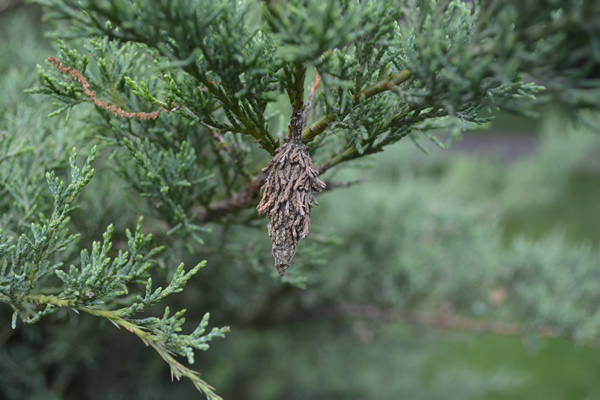Issue 3, May 20, 2019
Scouting for Bagworms
When the Japanese Tree Lilacs are in bloom, it is time to scout for and control bagworms. This species flowers later than other lilacs, with large fluffy white blossoms on a 20 to 30-foot tree. Known for their fragrant flowers in early- to mid-June, Japanese tree lilac is a common urban tree. In Bloomington, Miller Park has impressive specimens by the entry to the zoo.
But don’t get swept away in the aroma. On nearby evergreens there are tiny caterpillars climbing to the top of infested trees, spinning a single strand of silk to catch the wind and look for a suitable host. Juniper and arborvitae are the most susceptible but there are hundreds of other species that can be attacked, including pine and spruce. These tiny paratroopers have hatched from eggs overwintering in the bags from the previous season.
Small caterpillars feed on the outer layer of the leaves or needles on their host, causing browning, usually starting at the top of the tree. As they grow, their appetite increases and they begin to eat all of the foliage. They feed throughout the summer but are much easier to kill when they are small. These caterpillars remain susceptible to chemical treatment into early July. Heavy infestations of these insects can not only be unsightly with all the eaten foliage, but can kill branches or whole plants.
As the caterpillars feed, they produce silk and use foliage from the plant to create a bag. In late summer, these caterpillars pupate for about 7 to 10 days. The adult female remains in the bag and has greatly reduced legs, eyes and mouthparts. The males emerge from the bag as a black moth and find a female within a bag to mate with. After mating, she produces 500-1000 eggs, keeping them protected inside her body. Dissecting a bag in the early spring will reveal a dead female with lots of little eggs ready to hatch. As they are protected by the bag, control is futile until the eggs hatch and the juveniles emerge from their winter homes.
Any time of the year, removal of bags is good technique to employ. As the tree lilacs fill the air with their perfume, the following chemical treatments are effective: Bacillius thuringiensis kurstaki (also known as Btk, and found in Dipel and Thuricide), Spinosad (organically derived and found in products like Conserve) and cyfluthrin (Tempo) can be effective in ridding your landscape trees of future bagworm infestations. As always with pesticides, read and follow the labels to ensure safe and effective application. Follow up applications may be needed.

Bagworm
Author:
Kelly Allsup